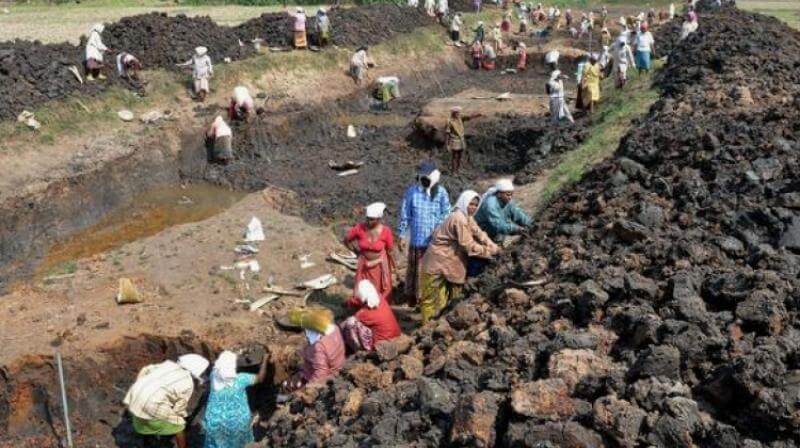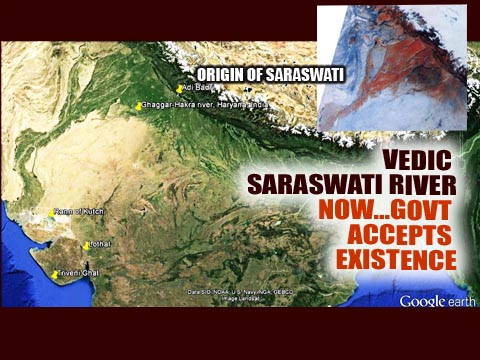

Pictures: The satellite image on the left is drawn in the map on the right, showing the Indus River in blue, the dry Sarasvati River basin in green and archaeological sites as black dots. Courtesy Dr NS Rajaram in HT
In March 2016, Government of India setup a panel of experts to review the available information from studies already conducted in Haryana and Rajasthan to find the evidence of lost Saraswati River. The seven-member expert committee was headed by Prof KS Valdiya, an eminent geologist. Previous studies by academics and National Remote Sensing Agency had indicated the present of a lost river in the area. Prof Valdiya is working with Jawaharlal Nehru Centre for Advanced Scientific Research in Bangalore. He has already written two books on Saraswati River- ‘Saraswati, The River Disappeared in 2002 and ‘Ek Thi Nadi Saraswati that was published in 2010.
Just last week the committee has submitted its report. While handing over the report to the government, Prof KS Valdiya said, “We have reached a conclusion that river Saraswati existed, it flowed. It originated in the Himalayas and met gulf at the Western sea”.

Picture: digging for the fresh water of the lost river
During its six-month research period of available information, the committee studied piles of sediments, their shapes and features which appeared to have been brought by a ‘big river’ and are reminiscent to such finds in Ghaggar, Ganga and Yamuna. “At some places, there is 30-ft deep sand layer (in the palaeochannels), at some places the width of the palaeochannels is five km and is filled with water.”
(A palaeochannel or paleochannel is a remnant of an inactive river or stream channel that has been either filled or buried by younger sediment. The sediments that the ancient channel is either cut into or buried by can be either unconsolidated, semi-consolidated, consolidated, or lithified: Wikipedia)
“This suggests that the relatively smaller rivers of today, like Ghaggar and its tributary Dangri, would not have brought such sediment. It must have been brought in by a big, flowing river,” Valdiya said.
In the report, the committee also observed that constituent minerals of the palaeochannels, at several spots, have come from catchment areas of Sutlej and Yamuna and from Greater and Lesser Himalaya. According to the report, Saraswati passed through Pakistan before meeting Western Sea through Rann of Kutch and was approximately 4,000 km in length. One-third of the river stretch fell in present-day Pakistan. The longer, two-third stretch measuring nearly 3000 km in length fell in India. Prof Valdiya stated, that around 1700 “small and big” towns and villages were located around the palaeochannel concerned during Harappa Civilisation.
“Some towns were spread over more than 100 hectares. These colonies were there for 5,500 years. Was it possible that these cities could live without water? No. It means that a flowing river provided water to the towns, villages. Which river it was? What was its name? We worked to find it out,” Valdiya said. “At some places, there is 30-ft deep sand layer (in the palaeochannels), at some places the width of the palaeochannels is five km and is filled with water.

The confirmation of the existence of ancient Saraswati River that flowed down from Himalayas into the sea off Gujarat is of profound significance. It completely demolishes the colonial fabrication of Saraswati as ‘myth’. If Saraswati was a ‘myth’ then, according to colonial Indologists and Leftist-Marxist historians, the Sanskriti which developed on the banks of the river was also ‘non-existent’! For centuries they have peddled their lies, even corrupted our education system, and have consistently denied the existence of a rich ancient civilization in India. They fabricated stories that some ‘Aryans’ from North-west brought knowledge to our land! The hogwash of ‘Aryan Invasion’ theory! I will dwell on it in another post as it requires detailed dissertation on it.
It is important to note that the report has confirmed the existence of Saraswati River but, the time frame investigated is only the ending phase of its history and its disappearance into the desert! With the question of Saraswati river’s existence settled, the next question arises- Since when Saraswati River existed relative to last ice age? Was there an ancient civilisation that thrived before Harappa and Mohen-jo-daro on its banks? How old was that civilization?
Herein lies the importance of discovery of ancient Dwarka off the coast of Gujarat, in the Gulf of Khambhat!
I will talk about that too in detail on another day.